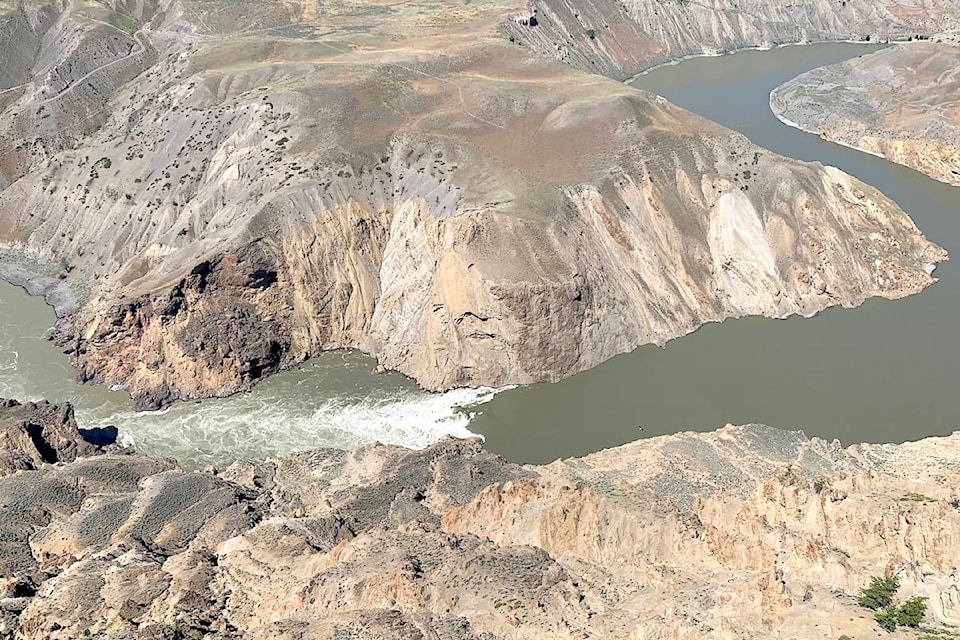Extraordinary efforts to remove the blockage at the Big Bar landslide on the Fraser River have been ongoing “full tilt” for weeks, and will continue until natural fish passage is fully re-established.
So far 12,000 fish have made it past the slide obstruction on their own, mostly chinook salmon.
“The situation is dynamic” at the remote section of the river, northwest of Kamloops, and conditions are “constantly changing,” said Kevin Skrepnek, information unit lead for Big Bar Incident Command Post.
An estimated 44,000 fish have been flown past the slide, Skrepnek told reporters on a media conference call.
Those airlifted fish, mostly sockeye and chinook, were moved “hand to hand” by personnel at the river’s edge, from seining net, to oxygenated tank, and were taken by helicopter upstream.
In all it means 56,000 fish have made it past the slide.
READ MORE: Transport by helicopter is painstaking
Michael Crowe, lead of environmental unit said in terms of the overall picture there has been notable “growth and positive” headway made in the numbers of fish moved, due to the unified response.
“There is a constant attempt to move forward and we are scaling up productivity on all fronts,” Crowe said.
Operations are at the base of a 125-metre cliff so it’s a very challenging work environment, with rock fall debris and unstable edges. But they are making definitive progress.
They’re planning to bring in more heavy equipment to create passageways for the fish, and anticipating a second fish wheel, and possibly dip-netting below the slide. But at this point the conditions are too dangerous to all the dip-netting to proceed.
From the engineering and rock work to provide natural passage for the fish on their own, they are seeing “considerable success,” from those efforts.
“This has been our main priority,” Crowe said.
There’s been an unprecedented government-to-government-to-government protocol in place, led by the unified command management team bringing together provincial, DFO, and First Nations experts, all working to free the fish pooling behind the slide in a narrow section of the Fraser.
The swift-moving water is impeding salmon and other fish from migrating upriver to reach spawning grounds, but they also created hazardous conditions for responding agencies at the site, which is not accessible by road.
So what are the next steps?
“Nothing is off the table unless it’s not feasible,” said Crowe, as they are looking for any and all solutions.
Other aspects of ramping up capacity so more fish can get past the blockage include expanding truck transportation. The plan is to re-open a rough road that provides access to the site, to be able to allow transportation by truck into the dawn and dusk hours, which helicopter transport does not allow.
Fish continue to be seined with nets and airlifted by helicopter, a painstaking and expensive process. The total cost of the operation to date has been about $6 million.
Sto:lo grand chief Ken Malloway, said the First Nations panel agreed to try opening the rough road to haul more fish by truck, with an estimated 2,400 fish a day that could be moved that way.
“The old road wasn’t being used but we realized it could be made passable so that’s what we approved last week.”
As co-chair of the Lower Fraser Fisheries Alliance, Malloway has been taking part in conference calls on the advisory panel, also representing the Fraser River Aboriginal Fisheries Secretariat.
The landslide could affect the entire ecosystem and other species dependent on the salmon survival, according to an update from the Incident Command Post in Lillooet.
“The inability of chinook, sockeye, coho and pink salmon to migrate above the landslide area this year, and in future years, could result in significant negative ecological, economic, and cultural impacts to all British Columbians and people throughout the region,” according to the ICP website. “Salmon are critical to Indigenous communities for food, social and ceremonial needs, and the slide has the potential to impact most Indigenous communities in B.C.”
READ MORE: Sockeye stymied in a bad year
@CHWKjourno
jfeinberg@theprogress.com
Like us on Facebook and follow us on Twitter.
